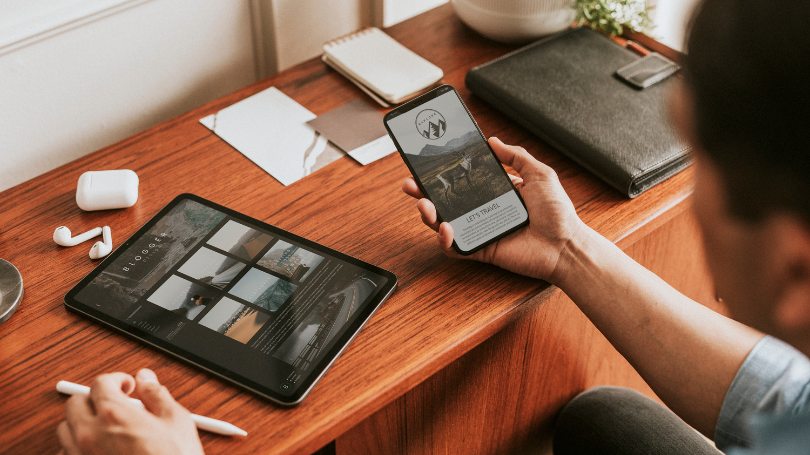Home / Functional Web Design / Mobile-First Design / Why Mobile-First Design is a Must for Digital Marketing Campaigns in 2024
Key Takeaways
- Mobile-first design ensures your website is optimized for the growing number of users accessing the internet through smartphones.
- Enhanced user experience on mobile devices leads to better engagement, longer visits, and higher conversions.
- Mobile-first indexing by Google prioritizes mobile-optimized websites in search results, improving your SEO ranking.
- Simplified navigation and touch-friendly elements are key features of mobile-first design that make websites easier to use on mobile devices.
- Cost-effectiveness is a major benefit, as mobile-first design reduces future redesigns and maintenance costs while improving ROI.
Optimizing Your Website for the Mobile-First Era
Did you know that in 2024, over 63% of website traffic in the US comes from mobile devices? This means most of your potential customers are likely browsing your website on their smartphones.
With this shift, having a website that merely functions on mobile isn’t enough. It needs to be designed with mobile users in mind from the start. Therefore, businesses in Dallas need to make sure their websites work great on phones, or they could lose customers.

Let’s say a potential customer in Dallas is searching for a “mobile first website design” on their phone. They find your website, but it’s not optimized for mobile. The text is too small, the images are too large, and the navigation needs to be clearer. Frustrated with this poor mobile user experience, they quickly leave and visit your competitor’s site, which is sleek, user-friendly, and built with a mobile-first approach.
This scenario highlights the importance of mobile-first design for digital marketing success in 2024. By prioritizing the mobile user experience, you can ensure that your website is accessible, engaging, and effective for the growing number of mobile users.
What are the Benefits of Mobile-First Design?
Enhanced User Experience
An excellent mobile experience keeps visitors engaged and encourages them to explore your site. A well-designed mobile interface encourages repeat visits, increasing brand loyalty and customer retention over time.
Improved SEO
Google prioritizes mobile-friendly websites in its search results, meaning mobile-first indexing can significantly impact your online visibility. Websites optimized for mobile rank higher in search engines, leading to increased organic traffic and a stronger online presence.
Increased Conversions
A smooth, natural mobile experience leads to higher conversion rates and more sales.
Focusing on intuitive navigation ensures users can easily find what they need, which further boosts conversion rates by reducing friction.
What is Mobile-First Design?
With more users accessing the internet through their smartphones, businesses need to prioritize the mobile user experience to stay competitive. But what exactly is mobile-first design, and why is it so crucial for digital marketing success in 2024?

Mobile-first design is a web design approach that prioritizes the mobile experience. Instead of designing for desktop first and then adapting for mobile (as in responsive design), mobile-first design starts with the smallest screen and scales up. This ensures that the focused content and functionality are optimized for mobile users from the beginning.
Mobile-first design means creating a website for phones first. You start with the most important features, like easy navigation and clear text. Then, when you design for larger screens like tablets and computers, you can add extra features and content.
Core Principles of Mobile-First Design
Content Prioritization
Mobile-first design forces you to prioritize your content. What’s the most important information you want mobile users to see first? This ensures that they get the essential information quickly and efficiently.
Simplified Navigation
Navigation menus should be concise and easy to use on a small screen. Menus should be simple to use, buttons should be clearly labeled, and important pages should be easy to find. Navigation is a crucial aspect of effective mobile optimization.
Touch-Friendly Elements
Buttons and links should be large enough and spaced out appropriately for easy tapping with a finger. Avoid elements that require precise mouse movements.
Concise and Scannable Content
Mobile users are often on the go. Use clear headings, bullet points, and short paragraphs to make content easy to scan and digest.
Mobile-First vs. Responsive Design
While both mobile-first design and responsive design aim to provide a good mobile experience, there’s a key difference. Responsive design adapts a single design to different screen sizes. Mobile-first design, on the other hand, starts with the mobile design and then enhances it for larger screens.
Why is this difference important? The mobile-first design essentially prioritizes performance and user experience on mobile devices, which is critical in today’s mobile technology.
By embracing mobile-first design, you’re not just creating a website that looks good on a phone; you’re building a foundation for a user-friendly and effective online presence across all devices. This approach is essential for businesses looking to succeed in the age of mobile-first indexing.
Why is Mobile-First Design Crucial in 2024?
Mobile-first design, an approach that prioritizes the design and development of websites and applications for mobile devices first, has become important for businesses and organizations to succeed in 2024. This strategy ensures that users on smaller screens have a seamless and engaging experience, leading to increased user satisfaction, improved conversion rates, and better overall business outcomes.

How Mobile-First Design Benefits Your Business
Mobile-first design isn’t just a technical consideration these days. It’s a strategic investment that can significantly impact your business’s bottom line. By prioritizing the mobile user experience and sticking to mobile-first design best practices, you can gain many benefits that translate into visible results. Let’s explore the benefits of mobile-first design for business.
Enhanced User Engagement
With so many distractions on mobile, keeping users engaged on your website is more important than ever. Mobile-first design helps you achieve this by creating a mobile-first website that is optimized for user engagement:
Reducing Bounce Rates
When a website loads quickly and is easy to navigate on a mobile device, users are more likely to stay and explore. This translates to lower bounce rates and increased engagement.
Increasing Time on Site
An excellent mobile experience encourages users to spend more time interacting with your content, browsing your products, or learning about your services. Longer user sessions translate into higher engagement metrics, which can positively impact SEO rankings and overall performance.
Improving User Flow
Easy-to-use mobile navigation guides users effortlessly through your website, leading to a more enjoyable and productive experience. This is a critical aspect of mobile optimization.
Increased Conversions
A positive mobile experience leads to higher conversion rates. When users can easily find what they’re looking for and complete desired actions on their mobile devices, they’re more likely to convert into customers.
Mobile-first design contributes to increased conversions by:
Streamlining the Purchase Process
A simplified checkout process makes it easy for customers to buy your products or services on their smartphones. This is especially important for mobile-first design for e-commerce websites.
Optimizing Calls to Action
Ensure your calls to action (CTAs) are prominent and easy to tap on mobile devices, encouraging users to take the desired action. Clear and accessible CTAs reduce the risk of drop-offs and increase conversion rates, whether for purchases, sign-ups, or inquiries.
Removing Friction Points
Identify and eliminate any obstacles that might prevent users from completing a conversion on their mobile devices. This improves conversion rate optimization (CRO) and overall SEO.
Better Brand Perception
Nowadays, brand perception is everything. A website that provides a poor mobile experience can damage your brand’s reputation and drive customers away.
Mobile-first design helps you build a positive brand image by:
Demonstrating Customer-Centricity
Prioritizing the mobile experience shows that you care about your customers and their needs, enhancing user experience (UX). A seamless mobile experience fosters positive brand perception, which can lead to word-of-mouth recommendations and brand advocacy.
Enhancing Credibility
A professional, well-designed mobile website builds trust and credibility with your audience. It signals to users that your business is up-to-date with modern technology, making it easier for them to trust your services or products.
Creating a Positive First Impression
Many customers’ first interaction with your brand will be on their mobile device. Make it a memorable one with an impactful user interface (UI). An intuitive UI creates a lasting impression, increasing the likelihood of users returning to your site and converting into customers.
Cost-Effectiveness
While implementing a mobile-first design may require an initial investment, it can lead to significant cost savings in the long run. A mobile-first approach minimizes future development costs as it avoids the need for multiple redesigns to keep up with mobile technology trends.
Here’s how you can save costs by implementing a mobile-first design:
Reduced Development Time
Starting with mobile design can smoothen the development process, as you’re building the foundation first. This is a key advantage of how to implement mobile-first design effectively.
Lower Maintenance Costs
A well-designed mobile-first website is typically easier to maintain and update. Regular updates and maintenance can be done more efficiently, reducing downtime and ensuring your site remains functional and secure.
Improved ROI
By driving more traffic, engagement, and conversions, mobile-first design can deliver a higher return on investment (ROI) for your marketing efforts. With higher ROI, businesses can reinvest in further growth strategies like expanded advertising or content development.
Future-Proofing Your Online Presence
The mobile revolution is not slowing down. As mobile technology continues to evolve, mobile-first design ensures your website remains adaptable and relevant.
By embracing mobile-first design, you’re not just optimizing for the way people use their phones today, you’re preparing your business for the future of the web and ensuring your website is ready for Google’s mobile-first indexing.
Mobile-First Design Best Practices
Understanding the importance of mobile-first design is the first step. Now, let’s explore the key mobile-first design best practices that will help you create an amazing mobile experience for your users and reap the mobile-first design benefits for your business. Implementing these best mobile-first design frameworks ensures your website is optimized for the mobile-first indexing era.

Prioritize Your Content
When designing for mobile, remember that screen real estate is limited. Start by identifying the most crucial information your mobile users need. This careful content prioritization is at the heart of effective mobile-first design. Consider elements like:
Contact Information
Make it easy for users to contact you. Consider placing a prominent “Call Us” button or a link to your contact page directly on the home screen. Simplifying contact options improves customer satisfaction, increasing the chances of immediate conversions or inquiries.
Key Products or Services
Make sure your most important products and services are easy to find. Use high-quality images and concise descriptions to capture attention. This is especially important for mobile-first design for ecommerce websites.
Call to Action
Encourage users to take the desired action (e.g., “Get a Quote,” “Shop Now”). Make your CTAs stand out with contrasting colors and clear wording. Once you’ve identified the essentials, streamline your content and remove any unnecessary elements that might clutter the mobile experience.
Simplify Navigation
Mobile navigation should be easy to use and effortless. Here are some tips for creating user-friendly mobile menus that contribute to a positive mobile user experience:
Use a Hamburger Menu
This iconic three-line icon is a widely used symbol for mobile menus. It helps save space and keeps the interface clean. Using the hamburger menu also makes navigation straightforward and allows for an uncluttered mobile experience.
Keep Menus Concise
Avoid overwhelming users with too many options. Prioritize the most important pages and organize subcategories using dropdown menus. This approach minimizes decision fatigue and allows users to quickly find the content they’re looking for.
Use Clear Labels
Make sure menu items are clearly labeled and easy to understand. Avoid using jargon or technical terms. Simple, clear labels improve user navigation, leading to better engagement and fewer drop-offs.
Consider a Sticky Menu
A sticky menu that stays at the top of the screen as users scroll can improve navigation, especially on longer pages. This feature keeps key navigation accessible, reducing the need for users to scroll back up to reach important links.
Design Touch-Friendly Elements
Mobile users interact with their devices through touch, so your design must be optimized for touch interactions. This is a crucial aspect of mobile optimization and an important principle of how to implement mobile-first design.
- Button size – Make sure buttons and links are large enough to be easily tapped with a finger. A good rule of thumb is to make them at least 44 pixels tall and wide.
- Spacing – Provide enough spacing between interactive elements to prevent accidental taps. Aim for at least 10 pixels of space between buttons and links.
- Touch targets – When designing touch targets, consider the size of the average fingertip. Avoid placing interactive elements too close to the edges of the screen.
Optimize Page Speed
Page speed is critical for a positive mobile experience and for ranking well with mobile-first indexing. Mobile users are often on the go and have limited patience for slow-loading websites.
Here are some tips for optimizing page speed:
- Optimize images – Compress images to reduce file sizes without sacrificing quality. Use tools like TinyPNG or ImageOptim to optimize your images.
- Minimize HTTP requests – Reduce the number of elements on your page to minimize the number of requests needed to load the page. Combine CSS and JavaScript files whenever possible.
- Use browser caching – Implement browser caching to store website data on the user’s device, allowing for faster loading on subsequent visits.
- Choose a fast web host – A reliable web host can significantly impact your website’s loading speed. Consider using a content delivery network (CDN) to distribute your content across multiple servers.
- Implement lazy loading – Load images and videos only when they are about to be seen by the user, improving initial page load time.
Prioritize Accessibility
Accessibility ensures that everyone, including people with disabilities, can use your website. Consider these accessibility best practices, which also contribute to good user experience (UX) and search engine optimization (SEO):
Use Sufficient Color Contrast
Ensure there’s enough contrast between text and background colors for users with visual impairments. Use a contrast checker tool to verify your color choices.
Provide Alternative Text for Images
Use alt text to describe images for users who are visually impaired or using screen readers. Make sure the alt text is concise and informative.
Use Clear and Simple Language
Avoid jargon and complex terminology that might be difficult for some users to understand. Use headings and subheadings to structure your content and make it easier to scan.
- Test and Iterate – Testing is crucial to ensuring the effectiveness of your mobile-first design. Test your website on various devices and screen sizes to identify potential issues.
- Use a mobile simulator – Tools like Google’s Mobile-Friendly Test or BrowserStack can help you see how your website looks and functions on different devices.
- Conduct user testing – Gather feedback from real users to identify areas for improvement. Use tools like UserTesting or TryMyUI to conduct remote user testing.
- Analyze user data – Use analytics tools like Google Analytics to track user behavior on your mobile site and identify any pain points. Pay attention to metrics like bounce rate, time on site, and conversion rate.
By following these mobile-first design best practices and continuously testing and iterating, you can create a mobile experience that delights your users, improves your SEO, and drives business success.
Mobile-First Design Examples
Now that you understand the principles and best practices of mobile-first design, let’s take a look at some websites that have successfully implemented this approach. These mobile-first design examples will illustrate how businesses across various industries are using mobile-first design to enhance user experience and achieve their digital marketing goals.

Randco
This site exemplifies offering a smooth, mobile-friendly experience where users can quickly browse products, navigate with ease, and make purchases without hassle. A mobile-first approach ensures that customers, who are increasingly shopping on smartphones, have a seamless experience from product discovery to checkout.
Key Features
- Clean and proper layout with a focus on product images.
- Easy-to-use navigation with a prominent search bar.
- Smooth checkout process optimized for mobile.
- Fast loading times and smooth scrolling.
Why It Works
This e-commerce website prioritizes the mobile shopping experience, making it easy for users to browse products, find what they need, and complete smartphone purchases. It also optimizes load times, ensuring quick and smooth interactions for shoppers.
Roto-Rooter
With most users accessing services via mobile devices, a mobile-first design like Roto-Rooter’s is essential for ensuring smooth interaction with customers. The website’s intuitive layout, mobile-friendly contact forms, and clear call-to-action buttons make it easy for users to engage with the business anytime, anywhere.
Key Features
- Clear and concise information about the services offered.
- Noticeable call-to-action buttons encourage users to get in touch.
- Mobile-friendly contact form for easy inquiries.
- Location map and directions for mobile users.
Why It Works
This website effectively presents its services to mobile users, making it easy for them to contact the business or find its location. The clear navigation and clickable contact options enhance user convenience and engagement.
D Magazine
Mobile-first design is crucial for content-heavy websites like D Magazine, where users primarily browse on mobile devices. The site’s mobile-optimized layout, fast-loading images, and simple navigation ensure readers can easily access articles, share content, and enjoy a hassle-free reading experience.
Key Features
- Readable content with clear headings and concise paragraphs.
- Mobile-optimized images and videos for fast loading.
- Social sharing buttons for easy content sharing.
- Simple and easy navigation for browsing articles.
Why It Works
This website provides a seamless mobile reading experience, allowing users to access and engage with content on their smartphones easily. The clean layout and responsive design make content consumption smooth and enjoyable.
These mobile-first design examples demonstrate the functionality and effectiveness of this approach across different types of websites. By prioritizing mobile users and implementing the best practices we’ve discussed, you can create a website that delivers an amazing mobile experience and drives business success.
Mobile-First Design Leading the Way in the Mobile Revolution
Nowadays, mobile-first design is crucial in any kind of business. By prioritizing the mobile user experience, you can ensure your website is accessible, engaging, and effective for the vast majority of internet users who rely on their smartphones to browse the web.

As we’ve explored, mobile-first design offers a wealth of benefits, from improved SEO and increased conversions to enhanced brand perception and online presence. By following these best practices, you can make your website attract more customers, keep them engaged, and help you reach your business goals.
Enhance Your Mobile Strategy with Expert Web Design Solutions
At Bless Web Designs, we design strategic solutions that fit your business goals. With our expertise in mobile-first design for Dallas local businesses, we ensure that your site performs seamlessly across devices while delivering results like improved SEO, higher conversions, and better customer engagement.
What sets us apart is our client-focused approach. We collaborate with you every step of the way, making sure that your vision is reflected in a site that resonates with your audience. We understand that your website is a key business asset, and we’re committed to helping you get the most out of it.
Looking to make your website more effective on mobile? Contact us today, and let’s build a site that brings your business measurable success.


